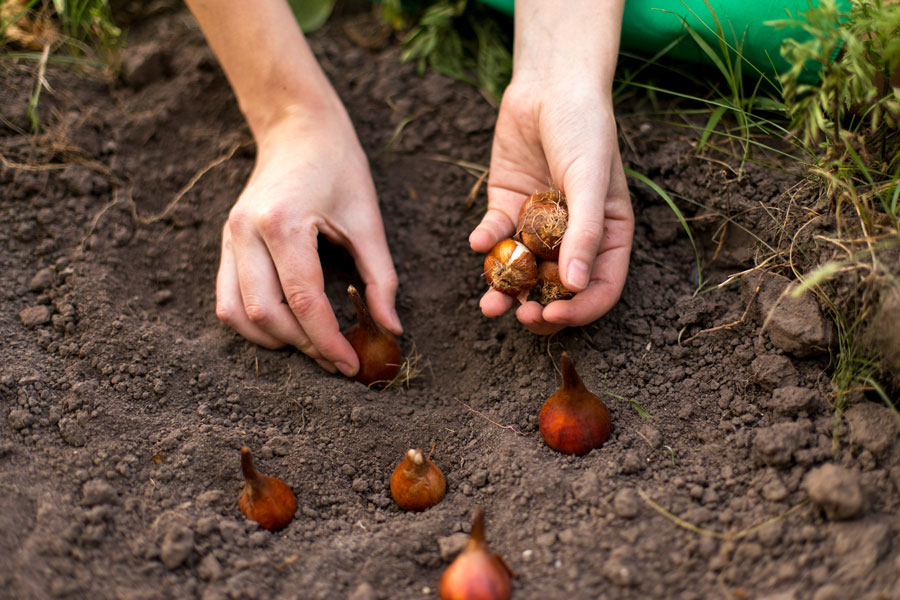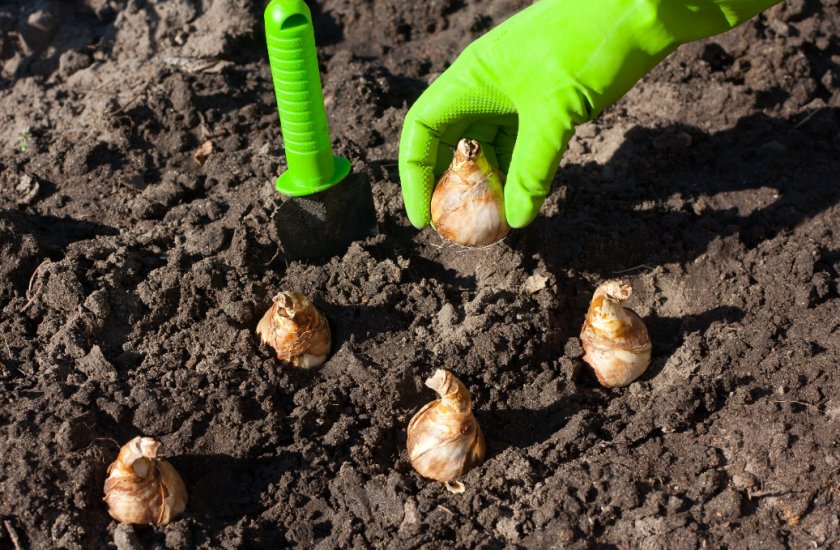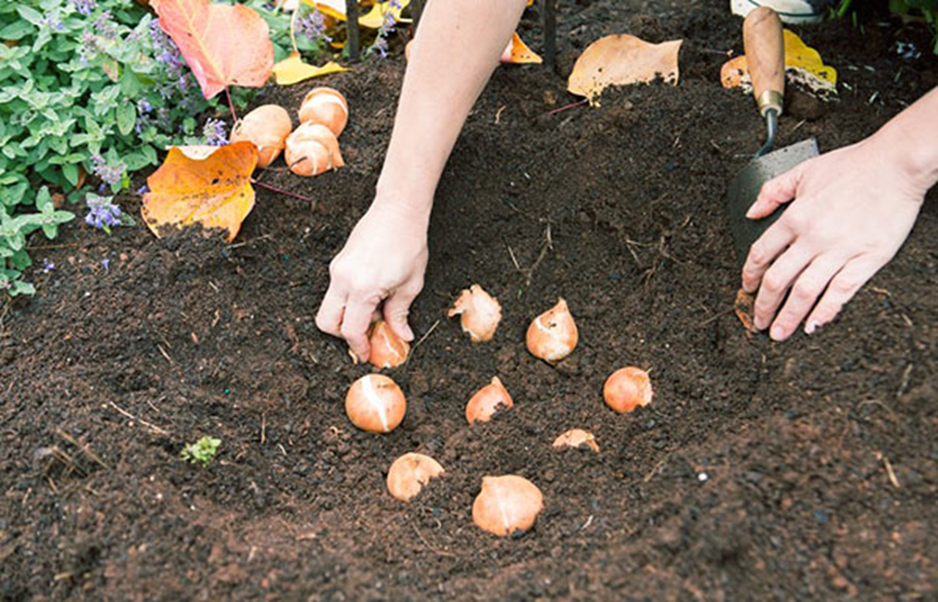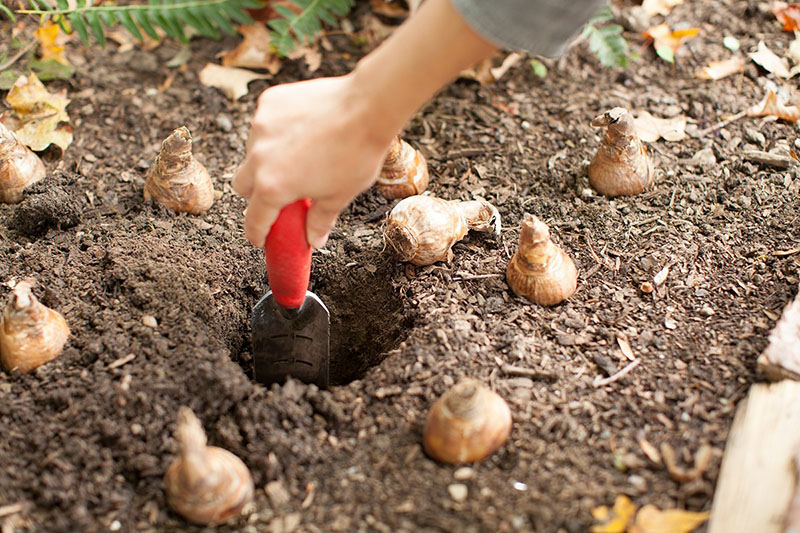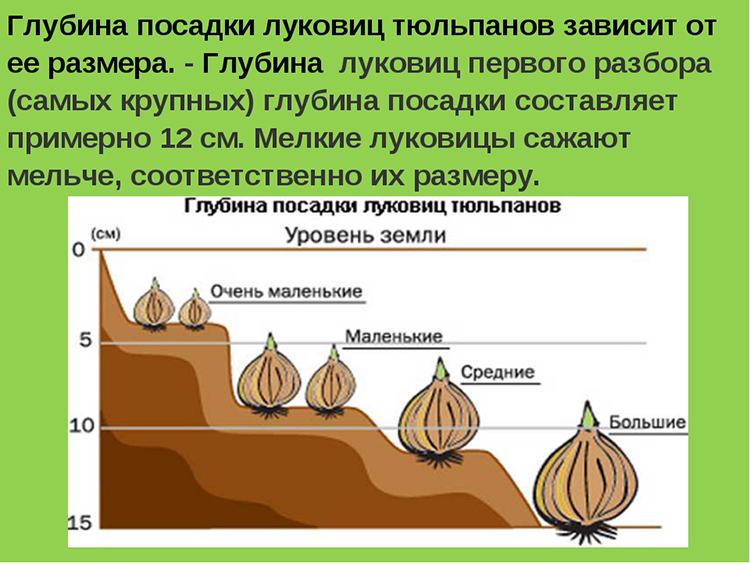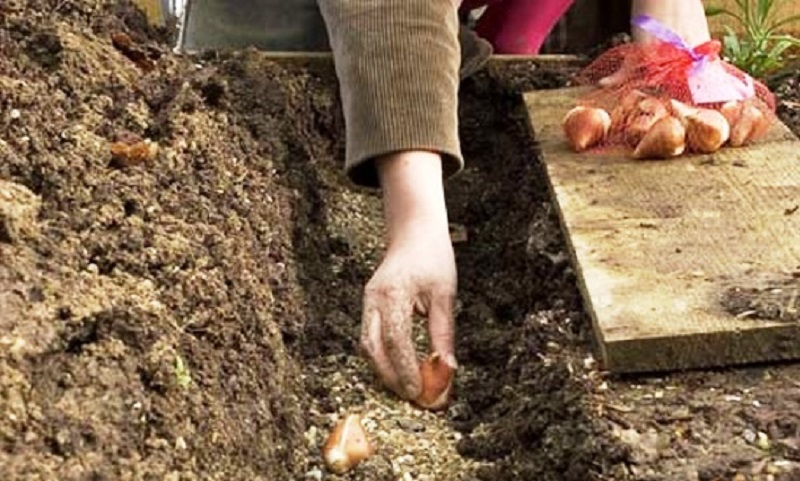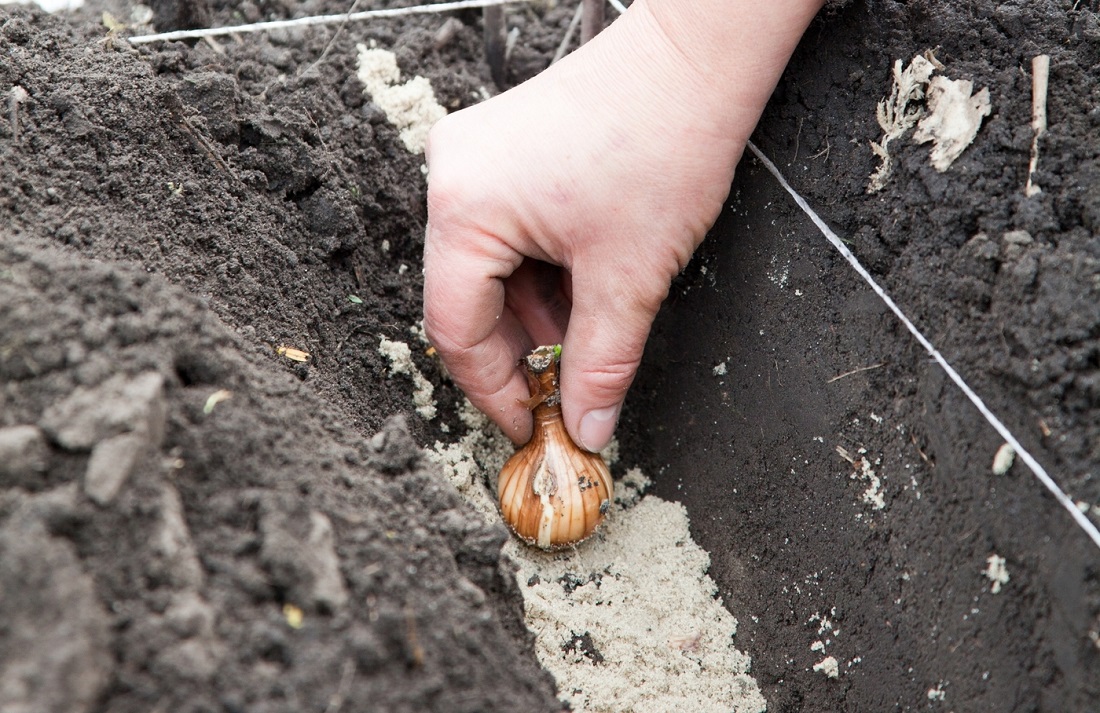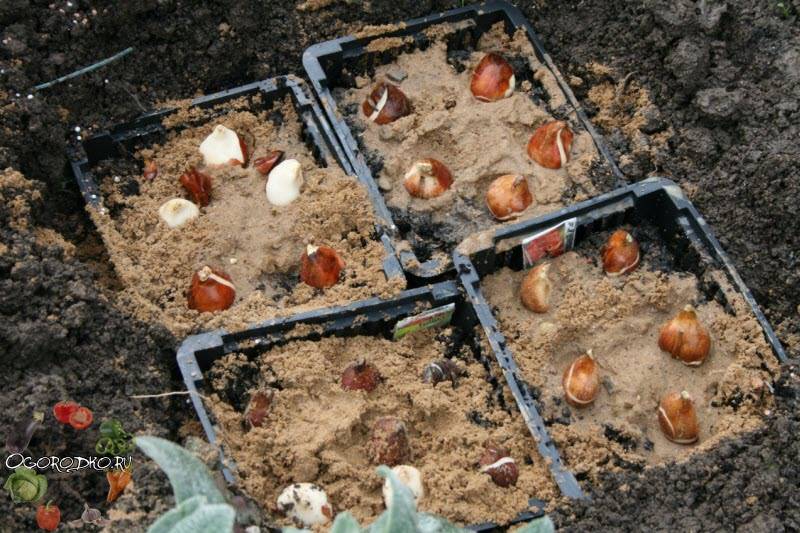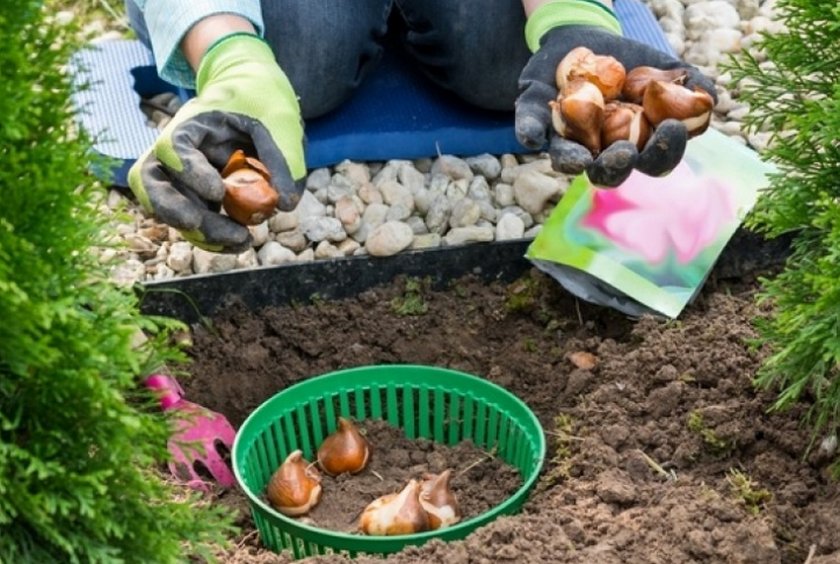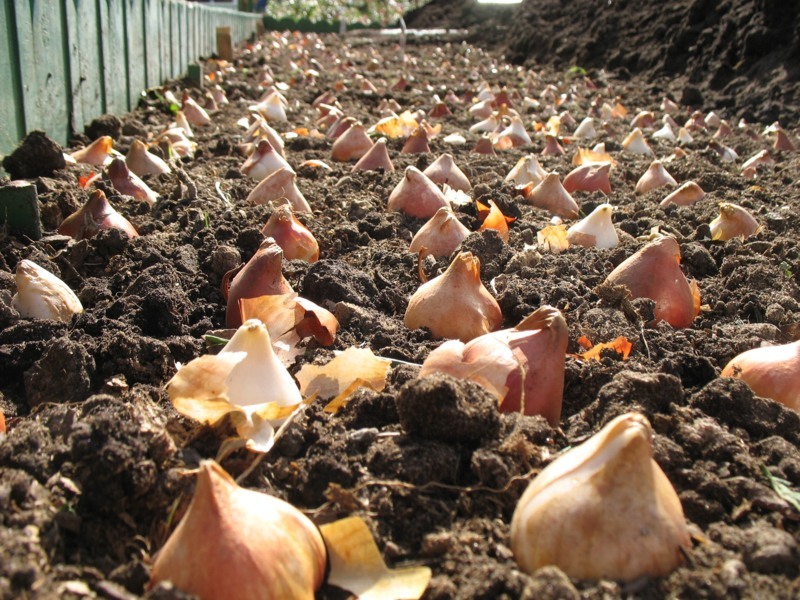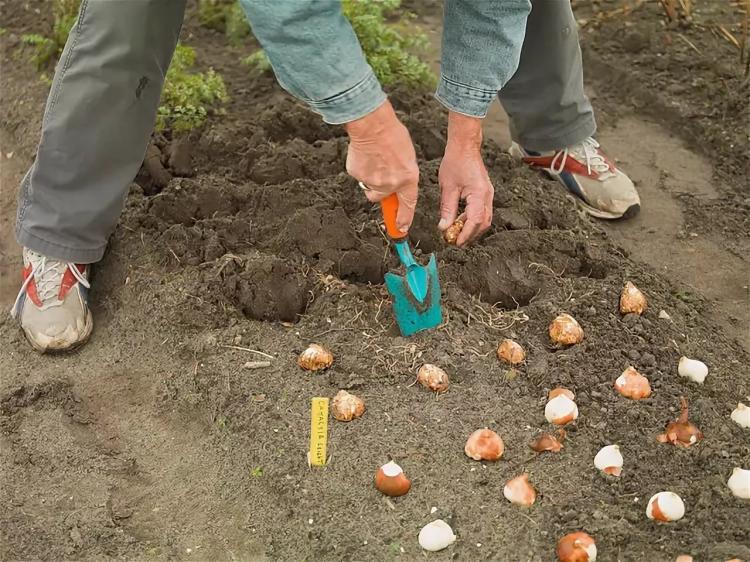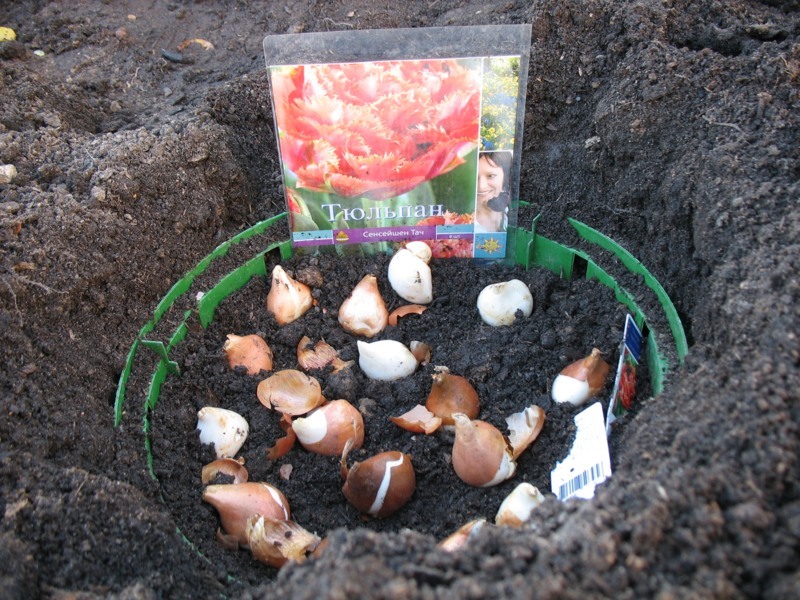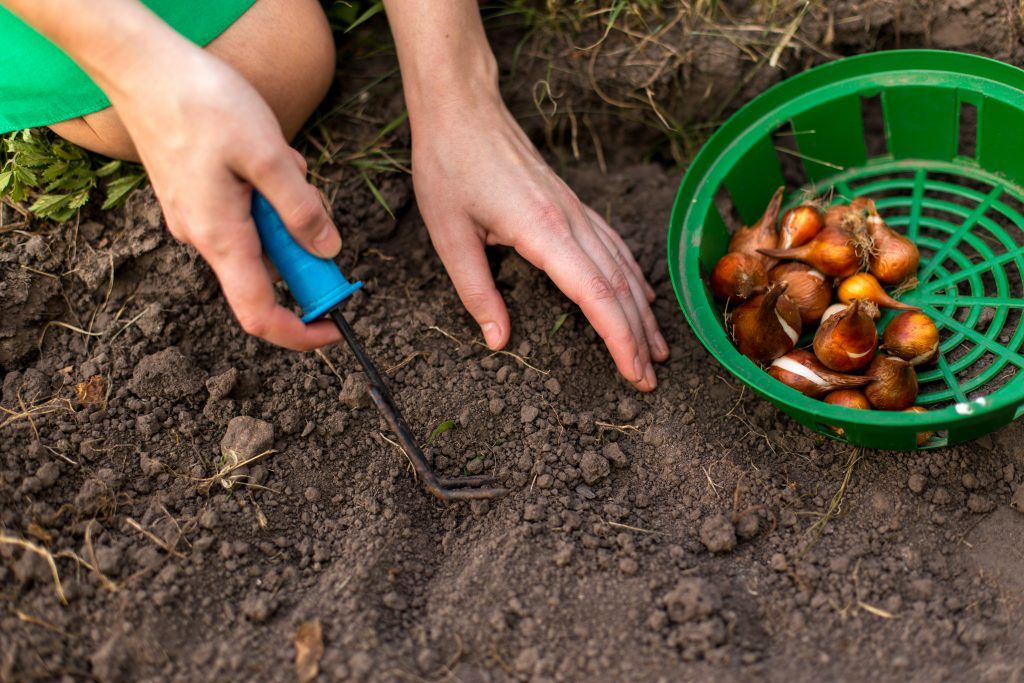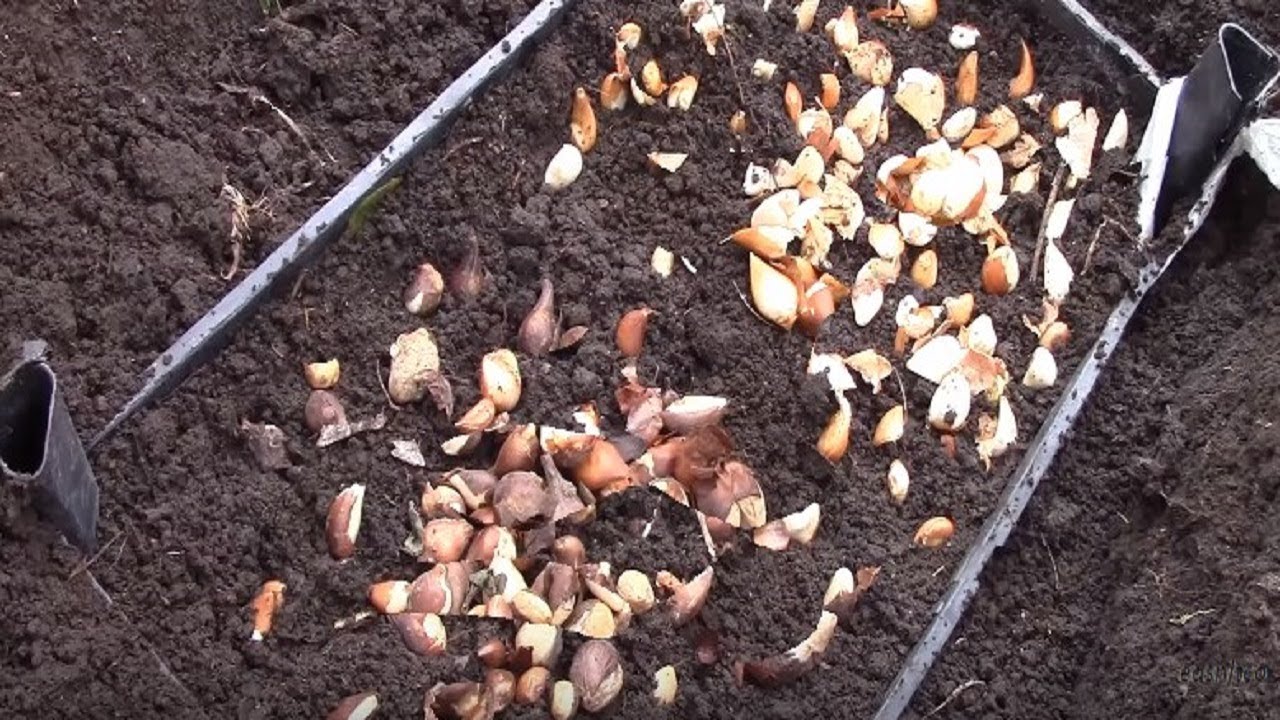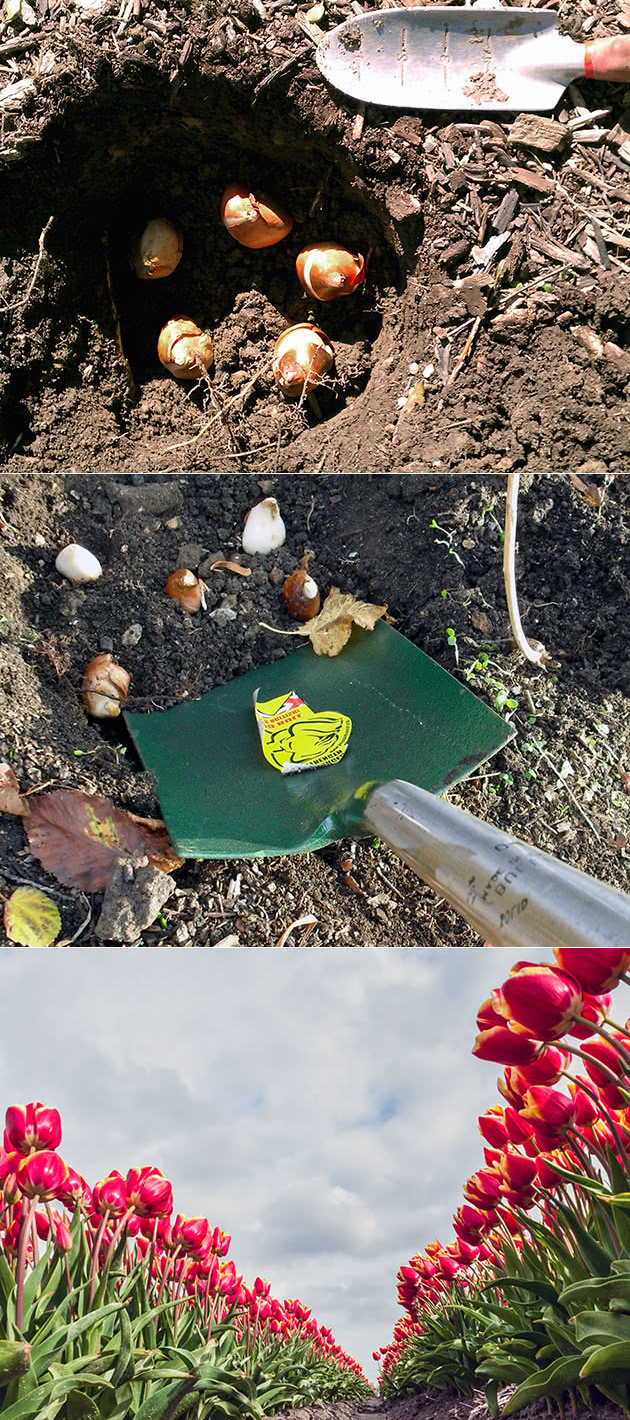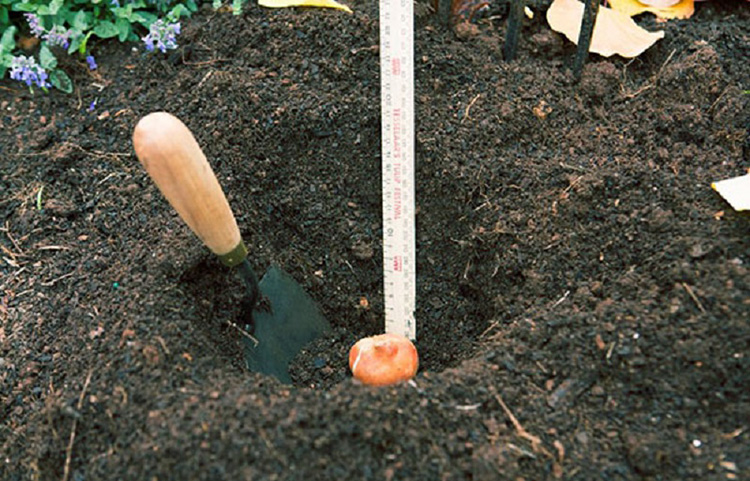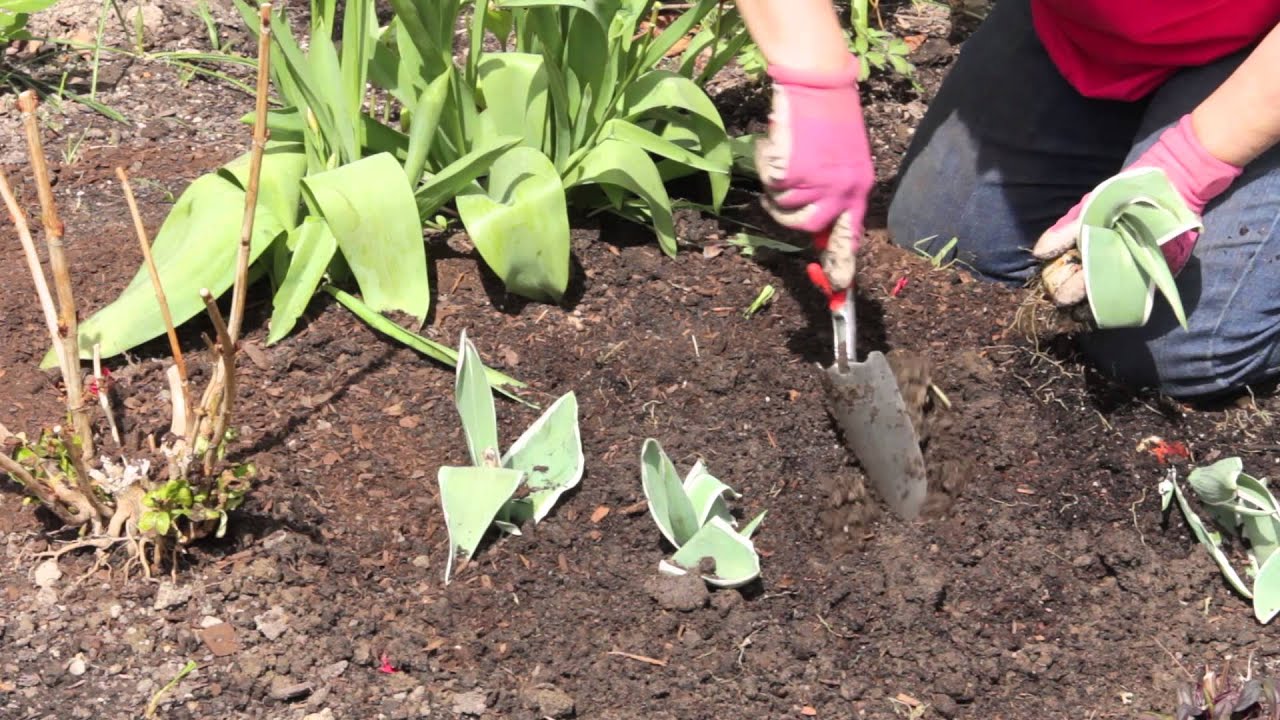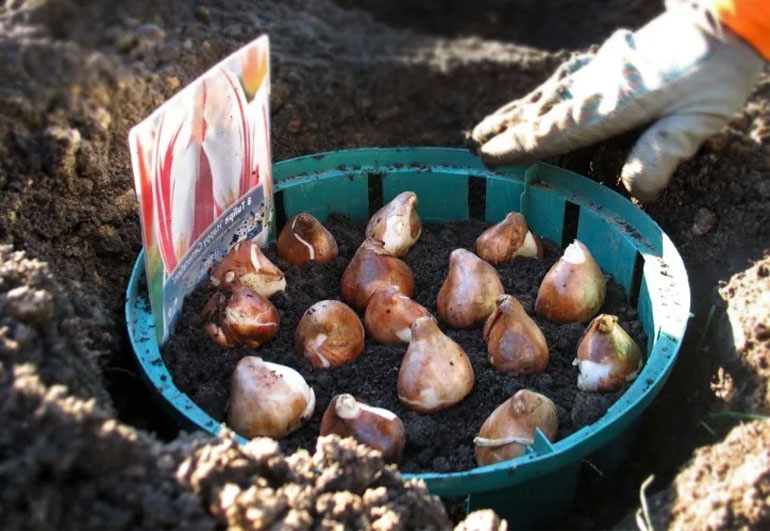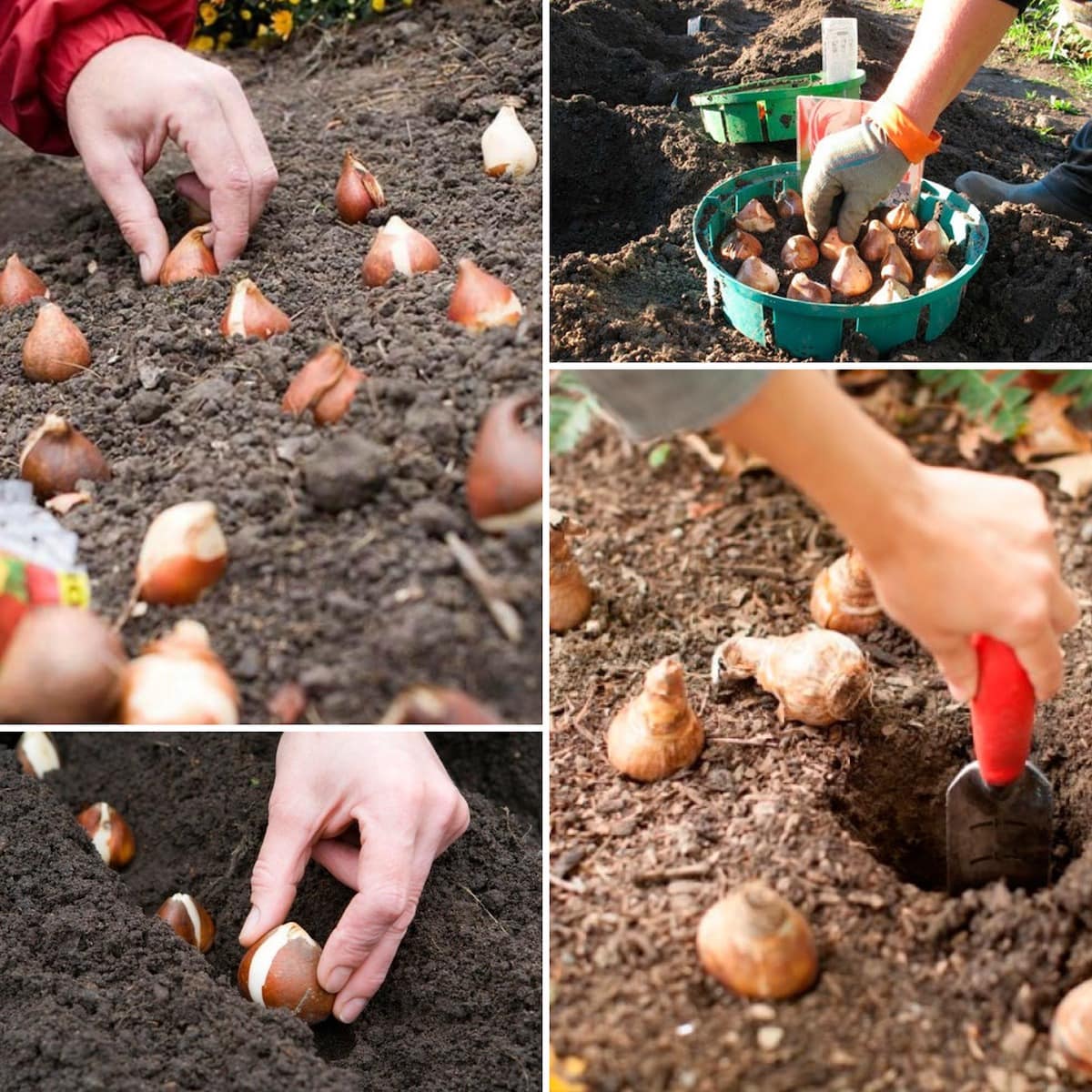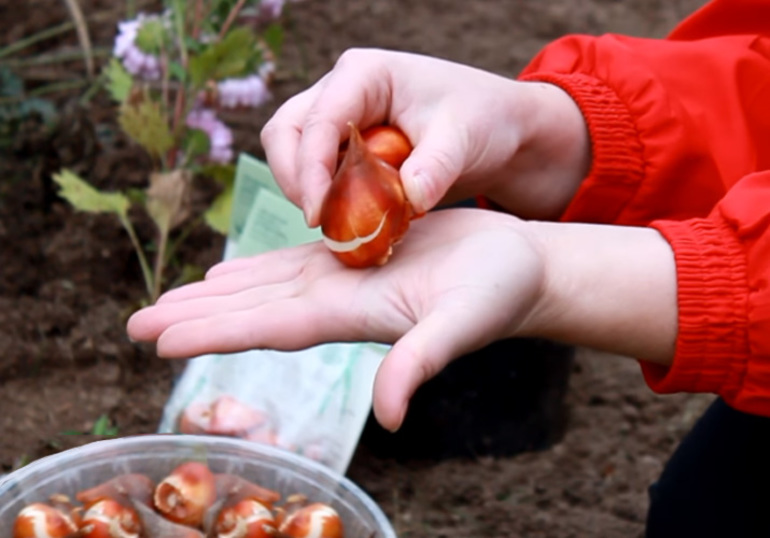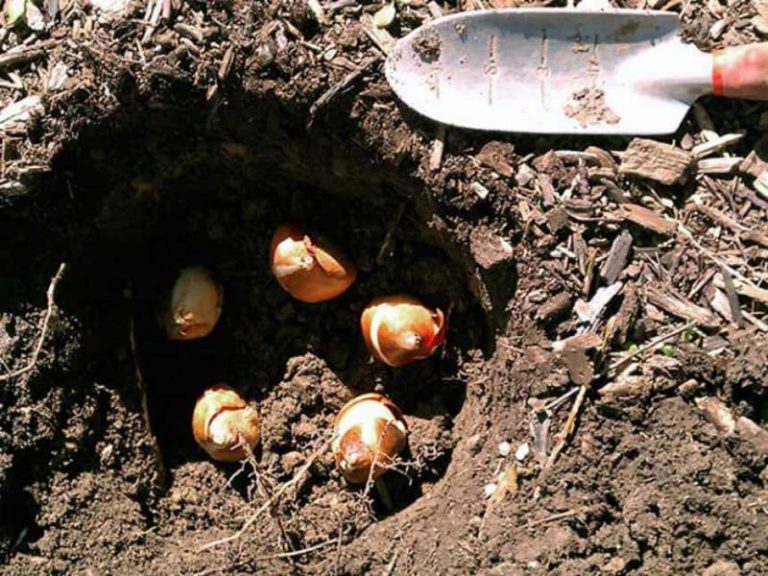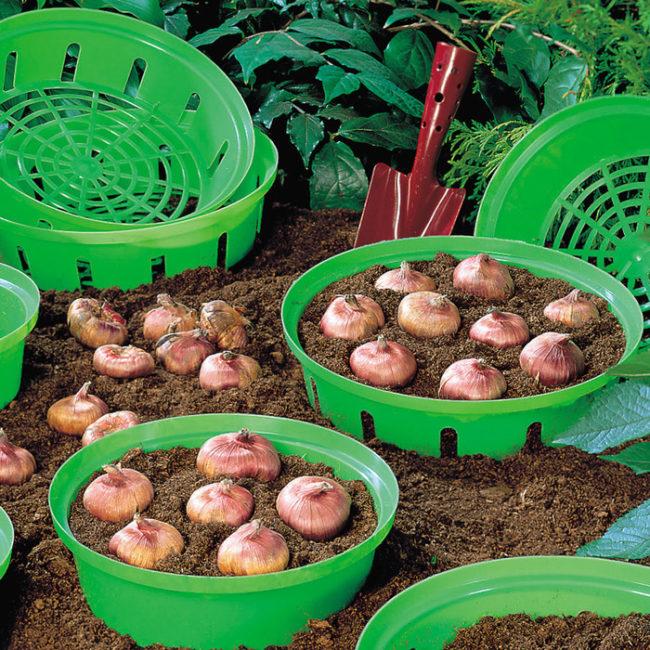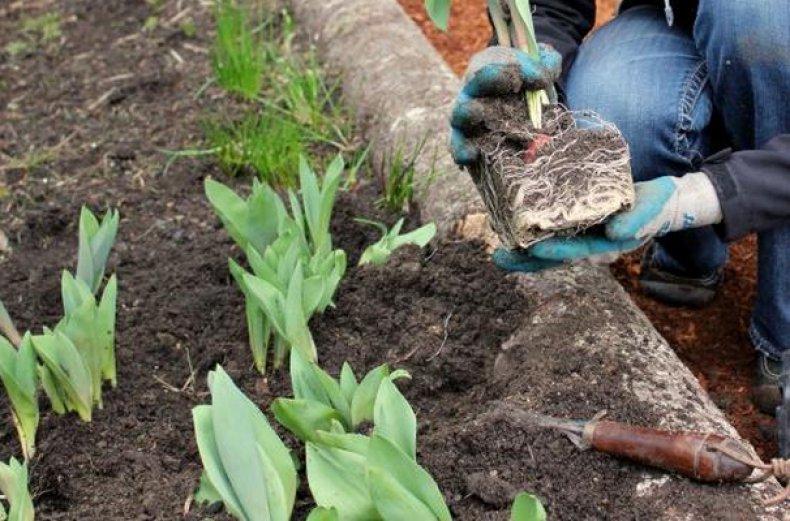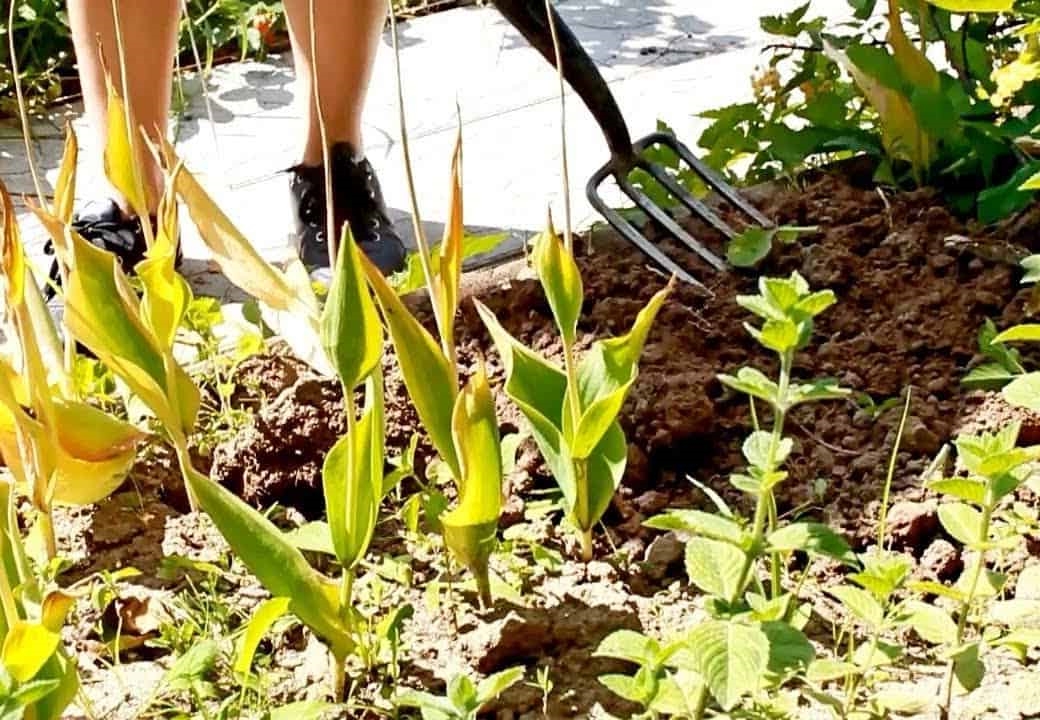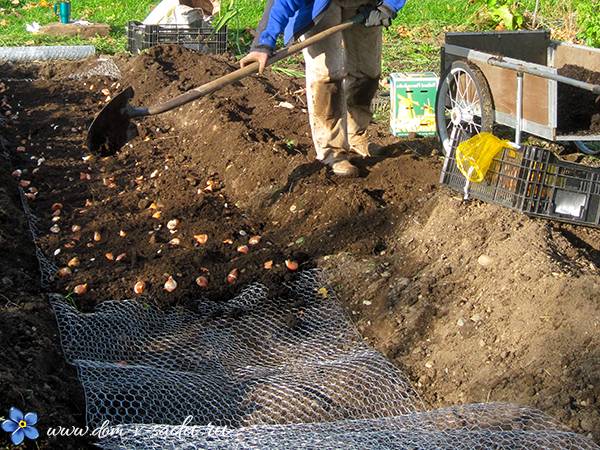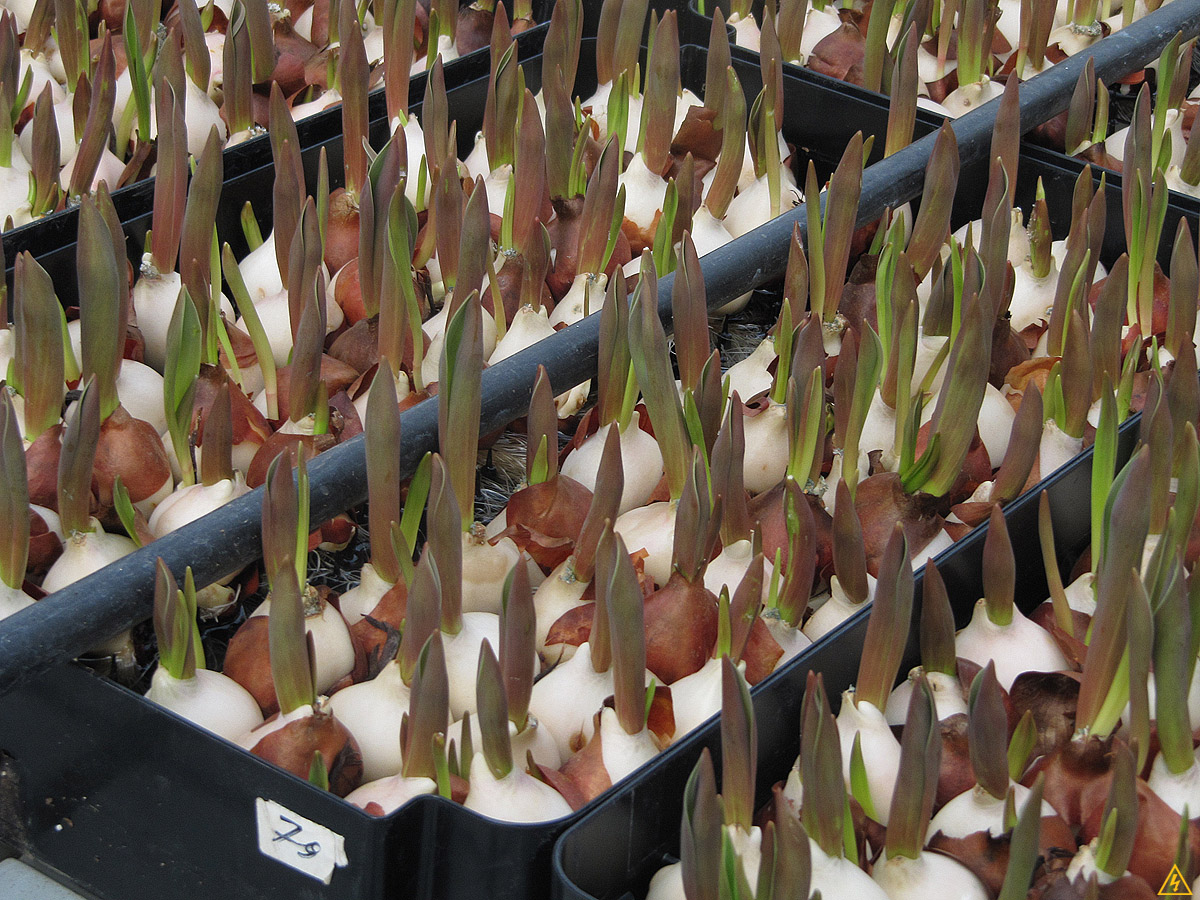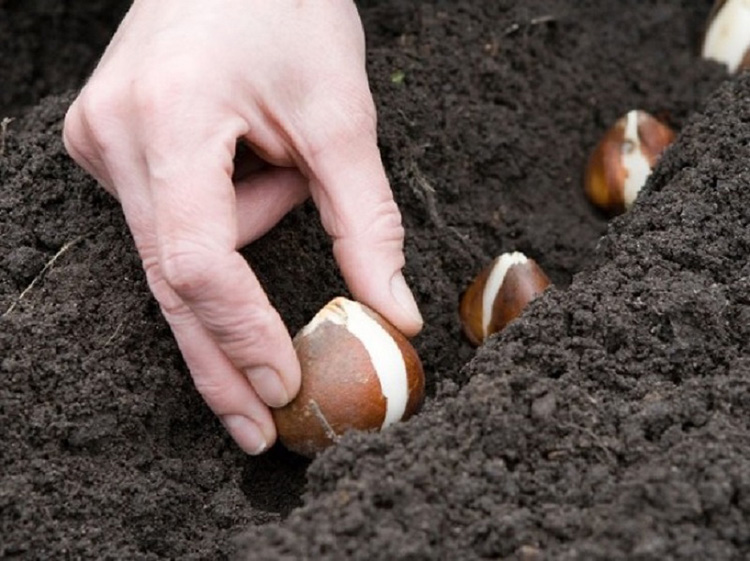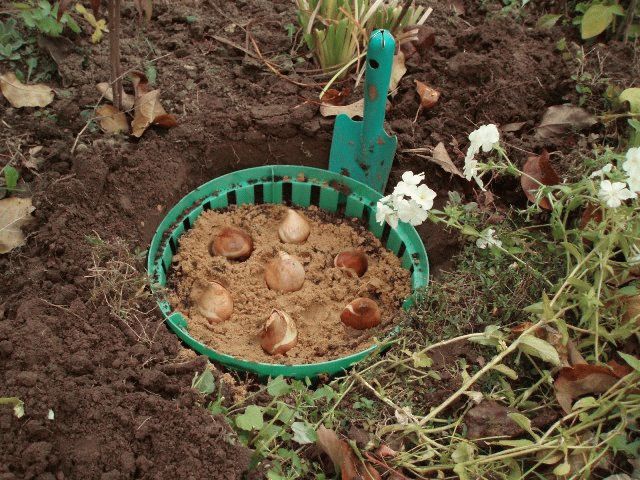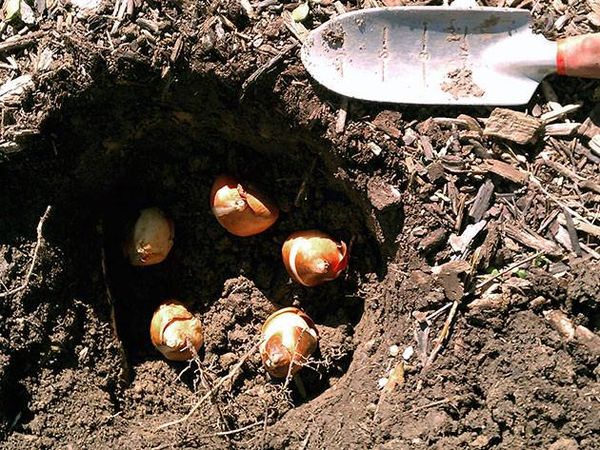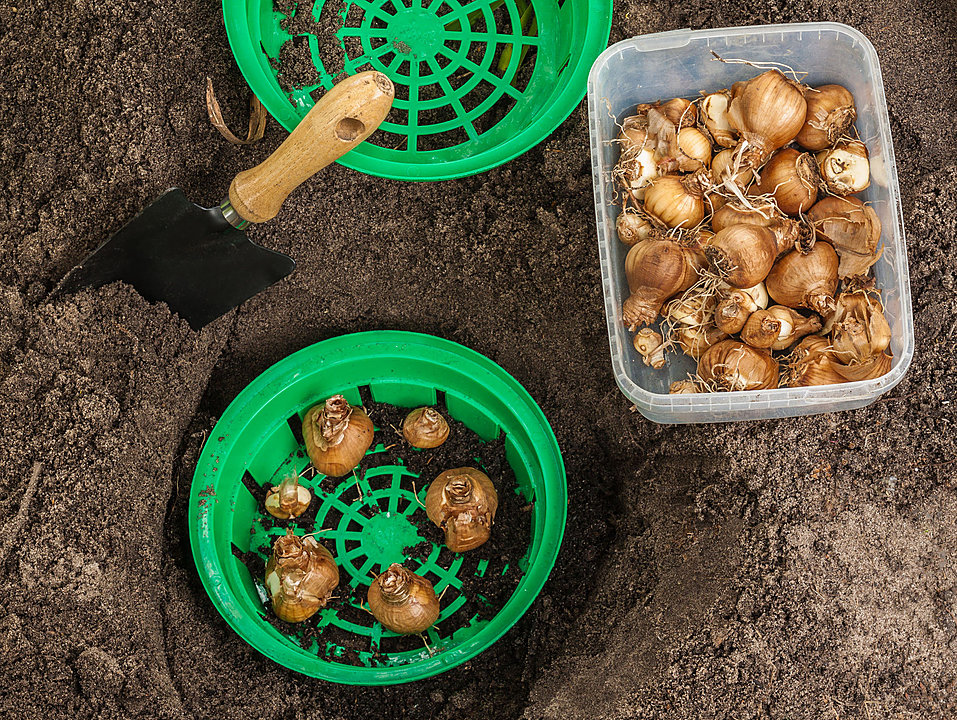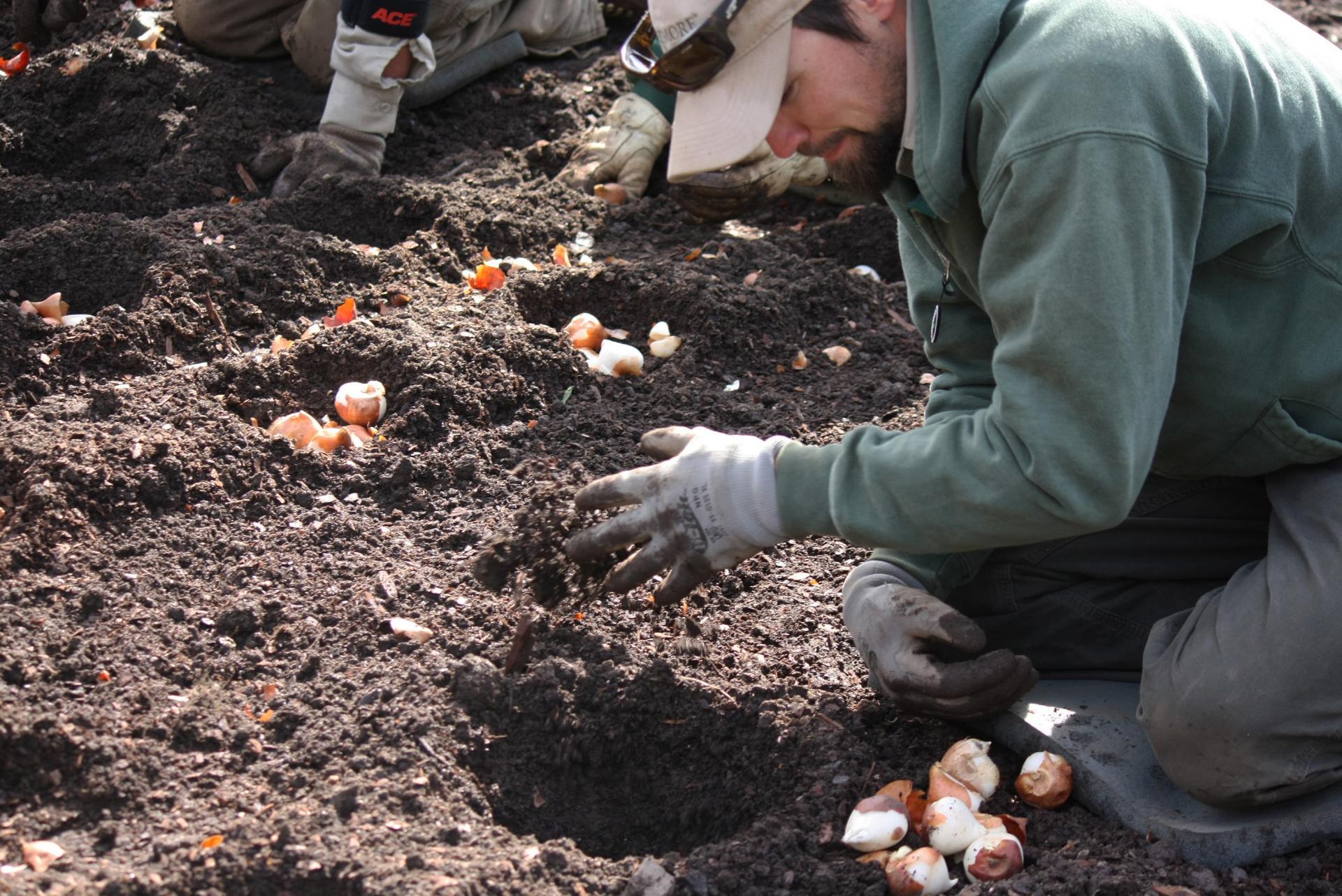When to dig tulips after flowering in the Urals
As already described above, tulips differ from other plants in their vegetation stages, and are dormant in summer. During this period, they will need to be dug up. The quality of the planting material depends on this event. If carried out late or too early, the bulbs will not take root during planting.
In order for the planting material to fully form during the growing season, when the flower fully opens (this is about 4 days from the beginning of flowering), it must be cut off. After such manipulation, the plant does not form seeds, and, accordingly, directs forces to increase the size of the bulb. Also, when tulips are cut for a bouquet, you need to leave at least 3-4 leaf plates on the plant. They are essential for root nutrition.

Digging time
They begin to dig up tulip bulbs when the foliage turns yellow, loses its turgor and begins to dry out. You should not wait for the complete withering away of the green mass. Bulbs overexposed in the ground are attacked by bacteria, as their integumentary scales are destroyed. The planting material dug out too early is not yet ripe enough. Accordingly, he cannot give full-fledged shoots. Dig the bulbous material in sunny, dry weather.
Find out more about whether tulips can be planted in spring.
How to dig it right
To carry out the manipulation, you will need a pitchfork or a shovel. Step-by-step instructions for digging tulip bulbs:
Set garden tools vertically 15 cm from the bush. Under no circumstances should the shovel (forks) be positioned at an angle. Otherwise, the risk of cutting the onion is very high.
Deepen the inventory 20 cm into the ground.
Raise the soil layer along with the bulb. Set aside.
Do similar manipulations with the rest of the plants
Carefully separate the soil from the bulbs with your hands. Wear gloves to avoid damaging your skin.
Separate daughter bulbs from mother bulbs.
Leave the planting material in the beds for a couple of hours, dry in the sun and ventilate.
Video: How to dig up and store tulips
Storing the bulbs
Before storage, the planting material must be prepared. To do this, you must first remove the roots on the bulbs. Then disinfect the raw material. To do this, you can use the drug "Maxim". 4 ml of the preparation (whole ampoule) is dissolved in 2 liters of water. The raw materials are soaked in a solution for 30 minutes. The specified amount is enough to process 2 kg of planting material.
After soaking, the raw material is dried for 2-3 days in the fresh air, but always in the shade. This is best done under a canopy.
Did you know? Tulips of different shades have their own symbolic meaning. So, red flowers represent passion, love, yellow - wealth, white - a plea for forgiveness, repentance.
Immediately after drying, the planting material is placed in a warm, dry, well-ventilated area. The optimum storage temperature is + 20… + 30 ° С. Closer to the middle of August, the temperature should be gradually reduced to + 14 ... + 10 ° С. If this is not done, the raw material may react poorly to planting in cold ground. It is best to place the material in wooden boxes in a single layer in the attic. Bulbs cannot be stored in a cellar or refrigerator, since in these places the temperature regime does not correspond to the required one.

It is very easy to grow tulips in the Urals, despite the harsh climate. The main thing is to comply with agrotechnical requirements and study in detail the features of the vegetation of plants. Then your garden will annually smell of beautiful flowers and delight the eye.
When to plant tulips in spring so they can bloom
In order for the bulbs planted in the ground to germinate and the tulips to bloom in the first year, the planting material is embedded in the soil in early spring.
When choosing a time frame, you must comply with the following requirements:
- planting is carried out from late March to mid-May - the colder the climate in the region, the later the bulbs are embedded in the soil;
- the earth should dry out a little - excess dampness leads to decay of the roots;
- tubers cannot be planted during a strong wind - it blows the earth off the bulb and can even pull it out of the ground;
- the ground should warm up to + 9 ° С at a depth of at least 10 cm;
- early varieties of flowers are planted in the first half of spring, and late ones from mid-April;
- the air temperature at the time of planting the bulbs in the soil must be at least + 6 ° С.
Did you know? The Netherlands is the world leader in tulip cultivation. More than 3 billion of these vibrant flowers are cut in the country every year.
How to plant a flower correctly
The bulbs are planted in furrows, which must be dug up to 15 cm deep. When planting plants, it is necessary to maintain a certain distance from each other, namely 20-30 cm.
A distance of 10 cm is kept between the furrows. If the soil is heavy, then it is not necessary to place the bulbs deeply, it is enough to bury them in the soil by 10–12 cm, bottom-down. It is not necessary to press the bulbs into the soil, otherwise you risk damaging the root system.

What is needed for landing
Before planting flowers, you need to decide on the varietal material and geometry of the landscape composition.
The gardener will also need special equipment, namely:
- Shovel. In order to dig up the soil, rid it of weed roots and apply top dressing, you will need a bayonet shovel. It will also be needed in order to dig up the bulbs at the end of the flowering season. For working with flowers, a shovel with a scoop length of 30 to 45 cm is best suited.
- The rake is used to crush the clods of soil before planting the flowers, and to bring the soil surface to the proper condition for planting tulips. The tool allows you to level and fluff the soil. The rake can be replaced with a hand cultivator.
- A boot, with the help of which even furrows are marked. Typically, the length of the cutting surface of such a tool is 25–35 cm. It is enough to penetrate deep enough into the soil. The sharp edge of the boot is also necessary in order to rid the flower crop from weeds during the growth process.
Important! If the soil is not sufficiently moist, then experienced gardeners put a small layer of sand on the bottom of the furrow and water it with water.
To plant bulbs in confined environments where a large number of plants are intertwined, gardeners use a special bulb planter. It is suitable for work in both "tight" and large flower beds.

Site selection and soil preparation
To plant flower bulbs, you need to take the choice of location seriously. It should be light and sunny. Tulips love loose, nutritious and light soil, which contains a lot of humus. If the soil on the proposed planting site is heavy, it can be "lightened" with peat or compost.
It is important to avoid areas in the lowlands, which are characterized by close water occurrence. This threatens to soak the planting material, rotting it, and in extreme cold - freezing.
Did you know? The closest biological "relatives" of tulips are asparagus and garlic.
The soil for tulips is desirable with a neutral pH level of 7.0-7.5. A month before the planting of the culture, the land on the site must be dug up 30 cm deep. Do not fertilize the tulip area in the year the bulbs are planted. Top dressing is best applied "under the predecessor".
For 1 m² of the planting area, it is recommended to seal up a mixture of the following components:
- humus - 2 buckets;
- ash - 0.5 l;
- sawdust - ½ bucket.

Bulb processing
Before placing the bulb in the ground, it must be inspected for defects and damage. If at least one specimen is affected by a disease, then for the rest there is a high probability of infection. Sore and rotten parts must be removed with a sharp instrument. 1–2 hours before planting, the seed should be dipped into a potassium permanganate solution (0.5%).

Landing
Planting is done immediately after soaking the bulbs, which must be placed in the furrows, sprinkled with ash and sand.
Important! Do not apply fresh manure under tulips. This can cause diseases of the plant .. The next layer is from the soil
It is important to remember that tulips do not return to their original place earlier than after 5 years. At the first frost, the flower planting area must be mulched. Peat is perfect for these purposes (layer up to 5 cm). The mulch will keep the soil at an optimal temperature and prevent the planting material from freezing. When warming occurs, peat does not need to be removed, it will help retain moisture at the roots
The next layer is from the soil
It is important to remember that tulips do not return to their original place earlier than after 5 years. At the first frost, the planting area must be mulched.
Peat is perfect for these purposes (layer up to 5 cm). The mulch will keep the soil at an optimal temperature and prevent the planting material from freezing. When warming occurs, peat does not need to be removed; it will help retain moisture at the roots.

When to plant tulips outdoors in autumn
Planting a bulbous crop before winter at the optimal time significantly increases the chances of success. If you plant it too late, then it will not have time to take root and will freeze out in winter. And if you do this too early, then because of the warm favorable conditions, it can germinate, which at the first frost will cause the bulb to freeze.
It is necessary to plant 3-4 weeks before the first frost so that the bulbs have time to take root. In this case, the soil should have a temperature of about 7-10 degrees Celsius at a depth of 10-15 cm. It is possible to plant approximately in early September and until the first half of October.
It is impossible to name the exact universal time of the procedure, which is applicable for the whole of Russia. Indeed, due to different weather and temperature conditions, the timing of planting tulips in autumn in open ground in different regions is different:
- In the Central lane (Moscow region) - the second half of September;
- In Siberia, in the Urals, in the North-West (Leningrad Region) - the first half of September (if the year turned out to be very cold, then even at the end of August);
- In the South (Krasnodar Territory (Kuban), North Caucasus) - the first half of October.
Dates of planting tulips according to the lunar calendar 2019
To determine the most accurate time for the procedure, many summer residents resort to studying the lunar calendar. Of course, the effectiveness of following the cycles of the moon in gardening has not been scientifically proven, but many flower growers and summer residents note that it works.
Thus, the optimal timing of planting bulbs according to the lunar calendar 2019:
-
Auspicious days:
- August - 4, 5, 6, 18, 19, 20, 21, 22, 23, 28, 29;
- September - 1, 2, 3, 4, 5, 7, 8, 9, 10, 17, 18, 19, 20, 21, 22, 23, 24, 26, 27, 30;
- October - 4, 5, 6, 7, 9, 10, 11, 12, 15, 16, 17, 19, 20, 21, 23, 24, 25, 26, 27.
-
Unfavorable days:
- August - 15, 16, 30, 31;
- September - 14, 15, 28, 29;
- October - 14, 28.
Tulip care
Flower care is directly dependent on weather conditions. During dry autumn, the planting site is watered abundantly. Water should saturate the soil by at least 30 cm. After that, the soil should be mulched with peat. The height of the peat layer should not exceed 3 cm. To improve the development of the root system, the flowers can be fertilized. This is best done in mid-October and ammonium nitrate: 15 grams per square meter of soil.
During frosts, the planting site is covered with spruce branches. This will protect the bulbs from rodents and save them from freezing.With the onset of spring, the spruce branches are removed. In the spring, tulips need to be fed with nitrogen fertilizer (50 grams x per 1 m2).

During growth, the plant needs several abundant watering. Make sure that the soil is soaked to the full extent of the tulip roots. Expect to use about 40 liters of water per square meter per watering. Tulips for a bouquet are cut with only one, maximum two leaves, otherwise you will not collect good bulbs in the fall. Be sure to decapitate (cut faded flowers).
To store the bulbs correctly, follow these steps in sequence:
- The bulb heads removed from the ground must be carefully sorted out immediately. Good ones to be set aside, damaged by pests or diseases - thrown away.
- Place the onions neatly in boxes or on a tray for ventilation. Do not stack the plants tightly, try not to touch each other.
- Tulips should be outdoors for several days. Do not expose the bulbs to direct sunlight, as this will damage them.
- Once dry, remove the bulbs until next season.
Soil care
Good soil should have the following properties:
- sufficient moisture capacity;
- looseness;
- air capacity.
You can cultivate the soil with the help of various dressings and fertilizers. You can buy them at any gardening store. Just remember that you cannot radically fertilize the soil if there are already plants in it. Choose a time when the soil is dormant and apply your choice of organic or inorganic fertilizers.
Temperature regime
Correctly selected temperature is the key to successful forcing of plants, storage of their bulbs and flowering.
Bulbs have a cold storage time of 3 to 7 months. At this time, physical processes take place that allow the flowering shoot to develop. If you shorten the cooling period, the flowers will grow with very short stems.
After the cold period, the bulb heads are stored in a well-ventilated area. It is better to maintain the air temperature in the region of 15-17 degrees, the air humidity should be 60-70 percent.
How to fertilize and feed
You can fertilize the soil with purchased formulations by purchasing them at any horticultural center or store. Remember that radical dressing should only be applied to pre-moistened soil to avoid scalding the plant root system.
After applying dry fertilizer, it is necessary to water the mail abundantly. The water will help deliver the fertilizer to the roots faster. It is good to feed with nitrogen, potassium and phosphorus during the appearance of the buds. Fertilizer proportion - 1/2/2. This will not only help to strengthen the root system, but will also have a beneficial effect on the speed of tulip growth.
Diseases and pests
The variegation virus poses the greatest threat to the flower. The disease manifests itself in the form of spots and stripes on the leaves and petals of the plant. Infected tulips are not treated, they will have to be thrown away, and together with the soil in which it grew. The excavated place should be generously watered with a manganese solution.
Fungal August is also considered a common disease. The disease manifests itself in the form of a curved stem, a striped flower and leaves dark spots on the bulb. It is better to remove the diseased plant, and fill the hole with a solution of manganese and cover it with ash.
For the prevention of diseases, after digging the bulbs, plant this place with marigolds, calendula or mustard. This simple method produces unparalleled results.
The main pests of plants include a bear, root onion mites, snails, and rodents. Do not forget to treat the bulb heads with a manganese solution before planting. And do not be lazy to inspect the flowers every day, collecting insects from them.
Practical advice for pest control. Dig a glass jar into the ground, filling it three-quarters with water.Once in the jar, the insect will not be able to get out on its own and will die.
Care after landing
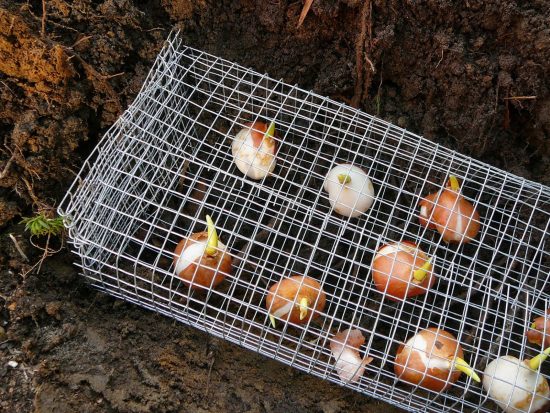
The introduction of fresh manure for planting tulips is unacceptable
If the fall is wet, the fall plantings do not need to be watered. In case of dry weather, you should check the moisture content of the soil by digging a hole near the beds. If the soil is dry, does not stick together in a lump when compressed, the tulip beds should be watered.
Tulips are hardy flowers, but it is best not to neglect frost protection. The beds for the winter need to be mulched, especially in regions with extremely low winter temperatures. To do this, use fallen leaves of trees, large sawdust, wood shavings, coniferous spruce branches.
Mulching protects the soil from cracking. Cold air enters the bulbs through the cracks, which can lead to their death. If the winter is very cold and there is little snow, less hardy hybrids may die. The ridges are additionally covered with snow.
In order for the bright corollas of tulips to please the eye for a month or more, it is recommended to plant different varieties. Early buds form three weeks after the emergence of shoots. Late tulips bloom until early summer.
Collection and storage of tulip bulbs
After the end of flowering, the remains of the flowers are cut off to prevent the formation of seeds. All the same, it will not be possible to breed plants from the grains, and the vitality is spent on their ripening.
As soon as the main part of the foliage (about 2/3 of the length) is dry, the tulip bulbs are dug up. If you skip this event, then for the next seasons the buds grow smaller, the planting of flowers thickens. We must also not forget about pests, because many bulbs die because of them.
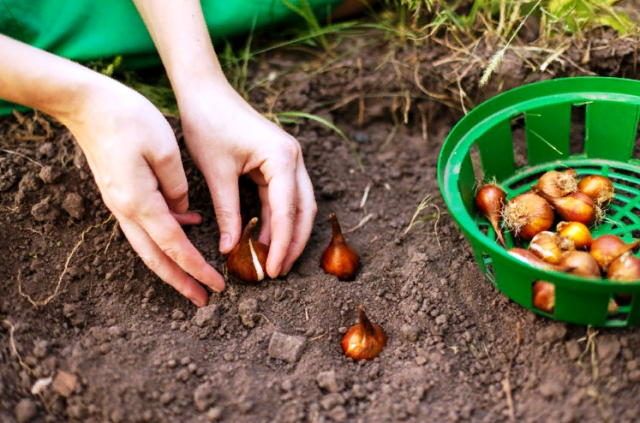
A good time to harvest tubers is fine, dry weather. Because the dug out bulbs must be dried, cleaned of soil residues, roots, dried leaves. In order for the seed to dry well, the tubers are laid out in one layer. Choose a shady and well-ventilated place.
More information on when to dig up tulips after flowering and how to store them.
How to store tulips before planting in the fall?
The bulbs are carefully folded into containers or any non-cardboard container. Paper boxes are not suitable, otherwise they can get wet and cause rotting of the planting tubers.
It may happen that in bad weather it will not be possible to dry tulips properly. Then all the planting material is lightly sprinkled with dry sawdust. Store containers in a cool, ventilated area.
It is not recommended to cover the seed, as the bulbs release ethylene, which has a detrimental effect on the tuber babies.
Periodically, the tubers are examined and discarded soft, covered with spots (white or yellowish), which can be symptoms of fungal diseases.
If you plan to plant in spring
What if you didn't manage to plant tulips in autumn? There remains the opportunity to plant them in the spring. In this case, the seed must be specially prepared in the fall. Freshly dug tubers are pickled with a solution of potassium permanganate. This technique will help protect planting material from diseases, pests, and prevent decay of individual bulbs.
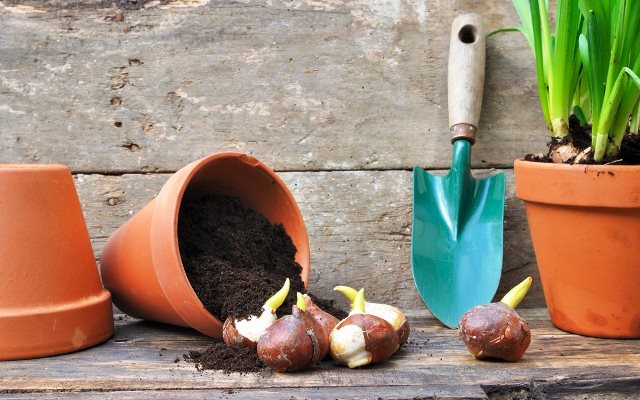
The tulips are dried and placed in a box with sawdust. You can wrap each tuber with paper. Bulbs should be inspected regularly before planting flowers in spring. Sick / damaged specimens are discarded immediately to preserve the rest of the bulbs.
A dry ventilated room with a temperature of 10-15˚С is suitable for storing planting material.
Before landing
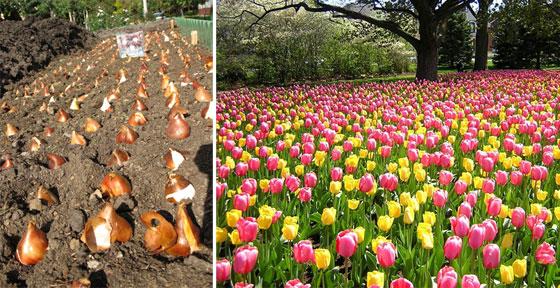 Tulips grow poorly and develop in drafts, but they like open, sunny areas
Tulips grow poorly and develop in drafts, but they like open, sunny areas
Planting tulips in the fall requires some preparation. For example:
- in advance and correctly choose a site for a future flower bed;
- take into account the amount of light;
- protection from strong winds - tulips do not like drafts and prefer the sunny side.
What to do before boarding:
 |
Step 1. Preparing the soil
|
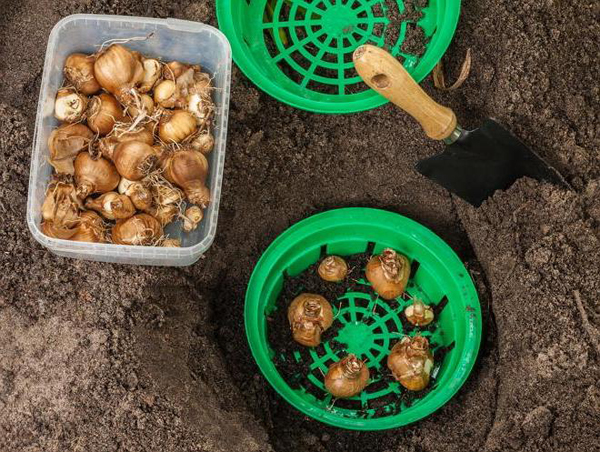 |
Step 2. Preparing the bulbs
To prepare the bulbs for planting, you need:
Processing before planting will disinfect seeds and protect them from pests |
It is very important for tulips that the soil is well drained. If the soil is dense and clayey, then drainage (expanded clay, pebbles, etc.) should be added to the holes (grooves)
sprinkle it with a layer of earth on top
 If the soil is dense and clayey, then drainage (expanded clay, pebbles, etc.) should be added to the holes (grooves), sprinkle it on top with a layer of earth
If the soil is dense and clayey, then drainage (expanded clay, pebbles, etc.) should be added to the holes (grooves), sprinkle it on top with a layer of earth
When to plant tulips in the ground before winter
Dates of planting tulips in the ground
When is it better to replant tulips: in spring or autumn? We are often asked this question, and not only by novice flower lovers, but also by people with already decent floriculture experience. But the autumn planting of tulips has long been considered more preferable than the spring one: tulips, the bulbs of which were planted in spring, bloom much later than tulips of the winter planting. And this is far from the only advantage of planting tulips in the fall. When planting in winter, the bulbs undergo a cooling period, during which they form the substances necessary for the rapid development of the flower. Under natural conditions, tulips begin to sprout as soon as the drifts disappear, so planting bulbs in winter is quite justified.
However, it is very important to correctly determine the planting time of tulips: if done too early, tulips will sprout and die in the first frost. In addition, if the autumn is warm and sunny, the flower bed will have time to overgrow with weeds, which will grow in spring and will take away food from the bulbs.
If tulips are planted too late in autumn, the bulbs may not have time to take root and die, and if they survive, they will lag behind in development in the spring.
To correctly determine the timing of planting tulips, you need to periodically measure the temperature of the soil at a depth of 15 cm: if it stays at around 10 ºС for several days, you can start work. The calendar dates for planting tulips change from year to year, because they primarily depend on the weather: last year you planted bulbs in September, and next season tulips are likely to be planted in August or November.
When to plant tulips in the regions
Tulips are planted in autumn in the Moscow region and in other areas of the middle zone when the air temperature in the garden drops to about 2-3 ºC, and the soil at a depth of 10 cm cools down to 6-9 ºC. Usually such conditions develop at the end of September and can last until mid-October. When to plant tulips before winter in places with early cold winters? The planting of tulips in the fall in the Urals is shifted by 10-20 days towards summer: the bulbs are planted from the second decade of September to the end of the month. Planting tulips in Siberia is usually carried out at the same time as in the Urals, but sometimes cold weather that comes too early can disrupt your plans for a sub-winter planting. Then it is better not to throw the bulbs into the frozen ground, but to plant them in the spring.
As for the recommendations of astrologers for 2017, then, according to the lunar sowing calendar, in September it is better to plant tulips on the 21st and 22nd, in October - 2, 3, 11, 21, and in November (this is a recommendation for Ukraine and southern regions of Russia) - 7, 8, 15 and 21 numbers.
Do not plant bulbs on full moon days (September 6, October 5-6 and November 4) and new moons (September 20, October 19-20, November 18-19).
Further care of tulips
Caring for tulips is not difficult. The main thing is to follow the basic rules of agricultural technology. Vegetation care consists in doing the following:
- timely removal of weeds from the garden;
- fertilization;
- soil mulching;
- adding a sufficient amount of water to the soil;
- warming plantings for the winter.
After the emergence of seedlings, it will be necessary to apply additional fertilizing 2 times during the period of active vegetation of the plants. The first is introduced after the snow melts into the moist soil to a depth of 5 cm. At this stage, a nitroammophoska is used. 30 g of the substance is introduced per 1 m². At the time of bud formation, watering is carried out with the addition of potassium-phosphorus elements. In 10 l of water, 20 g of superphosphate and 10 g of potassium salt are dissolved. This amount is enough to fertilize 1 m² of the area.
Weeding
Throughout the season, care should be taken to ensure that the area is not filled with weeds. They will take food from tulips, which will contribute to a decrease in their immunity, and, accordingly, the rapid reproduction of diseases and pests.
The manipulation is carried out as needed. They also regularly loosen the soil to a depth of 5 cm. It is best to carry out the manipulation a day after watering. This allows you to increase the access of oxygen to the roots and evenly distribute moisture in the soil.

Mulching
Mulching is carried out immediately after loosening and removing weeds. An agrotechnical technique allows you to slow down the spread of pest plants, as well as keep moisture in the soil longer. Hay or freshly cut grass can be used as mulch throughout the season. It is also a good option to combine sawdust and peat (1: 1).

Watering
Proper tulip care involves adding enough water to the soil. These plants have a weakly branched superficial root system, therefore, at the slightest drying out of the soil, they begin to grow worse, and the flowers become smaller. There is no specific schedule for irrigation. You should be guided strictly according to the weather and the stages of the growing season.
Also learn how to care for tulips after flowering.
Most plants need additional moisture:
- during budding;
- during flowering.
The soil under the tulips should be loose and moist at a depth of about 10 cm. 200-500 ml of water is consumed for each plant during irrigation. At the end of flowering, watering is carried out 3 more times. About 1 a week.

Warming for the winter
After the autumn planting, the plantings do not need care. Unless, if the weather is too dry, you will have to water it. About 10 liters of water are consumed per m².
With the arrival of cold weather, when the temperature drops to 0 ° C, the territory is insulated with mulch. To do this, lay a layer 10 cm high, consisting in equal parts of sawdust, peat, sand and compost. If there is little rainfall in winter, then it is imperative to make a snowdrift from the available snow over the tulip plantings. Under such a shelter, the flowers will normally survive, and in the spring they will give amicable shoots.
Did you know? During the Second World War, tulip bulbs were used as food by the Dutch. Today, dishes from different parts of this plant can be found in restaurants in Holland, France and China.
Preparing for landing
Regardless of the planting time, prior to this, pre-processing of the material should be done. It is identical to preparing the bulbs for storage.
Planting material processing includes several stages:
- cleaning the bulbs from scales;
- inspection and sorting;
- disinfection;
- processing of material with minor defects.
If the process of preparing tulip bulbs for planting is time-consuming, you can purchase ready-made material in the store that is processed in accordance with all standards. In this case, you need to buy quality bulbs from a reliable large supplier.
Thus, tulips need to be dug up annually and treated accordingly. Proper storage includes drying, warming and disinfecting the plant bulbs, which in turn stimulates the formation of flower buds. Planting material, which has undergone proper storage and processing, gives good flowering and the growth of young bulbs for breeding the variety.
There are different views on the advisability of digging up the bulbs. Some growers recommend removing and drying tulips not every year, but periodically, but the experience of well-known breeders suggests that it is better to do this annually.
Tulip care
Despite the fact that tulips are unpretentious flowers, improper care of them can lead to rotting bulbs or wilting foliage. That is why it is necessary to observe the frequency of watering and fertilize on time.
Care rules after flower germination:
- After the sprouts appear, the plant is carefully examined for dryness, wilting and darkening of the leaves. If there are any, they are dug up and destroyed.
- The soil near the sprouted bulbs is loosened in order to eliminate the problems of moisture stagnation and to enrich the rhizome with oxygen.

Proper watering
For plants to be healthy and beautiful, they need to be watered regularly. Drying of the soil and stagnation of moisture should not be allowed, therefore, the introduction of water under each flower should be moderate. For one plant, 200-500 ml of water is enough. It should be kept for 2 days and at room temperature, approximately + 18 ... + 20 ° С.
After each watering and rain, it is imperative to weed the earth. This procedure will avoid crust formation on the soil surface and will enrich the roots with oxygen.
Learn more about how to care for tulips after flowering.
Top dressing and fertilization
During the period of intensive growth and budding, 2 tulips can be fed.
Fertilization sequence:
- After the emergence of sprouts, fertilizing is carried out with nitroammophos (30 g per 10 l of water). The solution is used for 1 m² of area.
- During the budding period, potash and phosphorus fertilizers are applied. To do this, you can use potassium monophosphate, 10 g of which is diluted in 10 liters of water. This solution is used for 1 m² of area.

When to plant tulips in autumn
Usually, in the middle lane, the month of planting tulips is September, the second half of it, because the first one may still be too warm. Or even October, if September was too warm. In general, for planting, we are guided by the air temperature.
If it is higher, then the planted bulbs will wake up and start growing, but we do not need this. Because then they will inevitably die from winter frosts.
It is necessary that they remain sleeping in the ground until spring.
Therefore, we plant when it is already very cool. In the southern regions, planting dates can be shifted until November.
Interestingly, note that the price of tulip and daffodil bulbs drops sharply in October. They can be purchased at a huge discount for mere pennies.
This is a good time for enthusiastic gardeners in the middle lane and southern regions to purchase this inexpensive planting material and plant it.
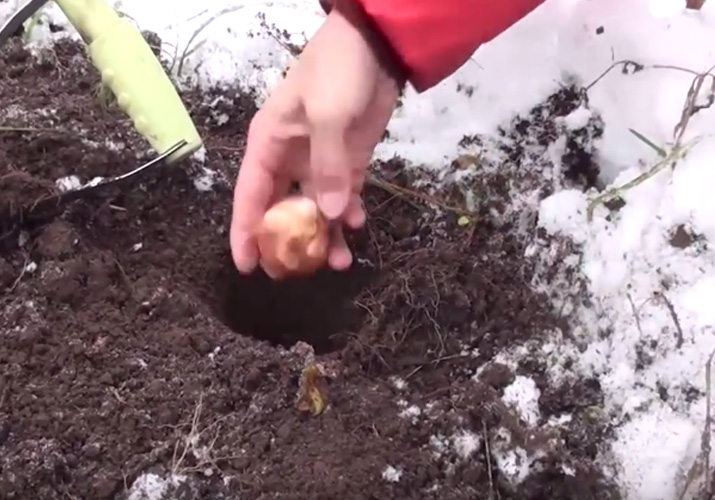
That's right, tulips are quite cold-resistant and can be planted even at the end of October, at temperatures close to zero.
Since in the middle lane the winter is with little snow, with thaws, the flower bulbs will have time to take root.
They will germinate well in spring, just bloom a little later than their counterparts planted in September.
But it's even great, when they all have already faded, you will still have tulips. So take note if you have a suitable region.In Siberia, of course, you can't experiment like that, frosts come too early.
Please note that tulips are not planted in spring, this is against their nature. Their time is autumn
So we don't store the bulbs until spring, we plant them.
Planting conditions for tulips
So it's time to board. How much tulip bulbs need to be buried and what distance between them should be depends on the size of the bulbs themselves. The larger the bulb, the deeper it must be immersed and the greater the distance must be left between the specimens.
For example, small (up to 3 cm in diameter) bulbs are planted to a depth of 6 to 8 cm.And large bulbs are buried by 12 or even 14 cm.
The distance between the planted tulips also depends on what you are growing them for. If for a cut, then it is permissible to plant tulips after 8-10 cm. But if you want to get a beautiful flower bed, then plant flowers in rows. The distance between the rows should be 15-20 cm, and between the flowers - 10-20 cm.
If you are growing dwarf varieties, plant the bulbs a little thicker, otherwise the flower bed will seem empty.
When growing tulips in a flowerpot, leave a 5cm gap between the bulbs.
After 10-14 days, the rooting of the bulbs begins. In warm and humid autumn, this happens faster. But if you do not want to depend on the weather, cover the planted bulbs with a layer of humus 5-7 cm thick or mulch with something else. This will protect the soil from hypothermia, and therefore, the bulbs will develop normally.
It is best to complete the tulip planting a month before the expected frost, because well-rooted bulbs can tolerate adverse conditions and temperature changes more easily.
As you can see, planting tulips does not imply any particular difficulties, but the requirements of agricultural technology of this culture must be observed if you want to grow bright beautiful flowers that will give healthy planting material by autumn.
Yarrow: properties and contraindications, planting and care Tulips - care in the garden
After this article, they usually read
Add a comment

